Study of Application of Fiber Reinforced Concrete in Anchorage Zone
Abstract
:1. Introduction
1.1. Anchorage Zone
- ▪
- Theory of Elasticity,
- ▪
- Equilibrium Method of Elasticity,
- ▪
- Strut and Tie model,
- ▪
- Finite Element Analysis,
- ▪
- Experimental Solution.
1.2. Fiber-Reinforced Concrete
1.3. Bending Test
1.4. Fracture Energy
1.5. Crack Development Mechanism
- (1)
- Zone without stress;
- (2)
- The zone in which the fibers bridge the crack—the stress is transmitted by the fibers;
- (3)
- Matrix process zone containing microcracks but with sufficient continuity.
2. Experimental and Numerical Analysis Performed on Beams
3. Numerical Analysis of Anchorage Zone
3.1. Specimen of Anchorage Zone
3.2. Nonlinear Numerical Analysis
4. Discussion
5. Conclusions
- The lower volume of Dramix 3D 55/30 fiber (75 kg/m3) does not significantly influence the response of the compressed anchorage zone, and the performance is similar to standard reinforced concrete.
- A higher volume of Dramix 3D 55/30 fiber (110 kg/m3) can increase the load-carrying capacity of the anchorage zone. In the case of the performed analysis, the resistance was higher by nearly 10%, and the cracks were formed for approximately 14% higher load in comparison with standard reinforced concrete and the lower value of fiber.
- The cracks were only longitudinal, so in the case of the analyzed specimen, the transverse tensile stresses were successfully transferred into the conventional reinforcement and fibers.
- Consequently, it can be stated that the addition of fibers leads to better mechanical properties of the anchorage zone. Besides the higher tensile strength, the compressive strength was also increased.
- The analysis of different types of anchorage zones—the study of eccentric anchorages and anchorage zones with multiple anchorage plates and sizes.
- Application of various types of conventional reinforcement arrangements and concrete classes.
- Comparison of performance of different types of fibers—length, shape, and material.
- Assessment of the fiber volume.
Author Contributions
Funding
Conflicts of Interest
Nomenclature
| PC | prestressed concrete |
| RC | reinforced concrete |
| FRC | fiber-reinforced concrete |
| FRC 75 kg/m3 | fiber-reinforced concrete—fiber volume of 75 kg/m3 |
| FRC 110 kg/m3 | fiber-reinforced concrete—fiber volume of 110 kg/m3 |
| Ec (Es) | modulus of elasticity |
| fc,cyl | cylindrical compressive strength of concrete (MPa) |
| ft (fr) | tensile strength of concrete (MPa) |
| fy | yield stress/strength (MPa) |
| NA | numerical analysis |
| FEM | finite element method |
| ft | tensile strength of concrete (MPa) |
| Gf | fracture energy (MN/m) |
| ν | Poisson’s ratio |
| W0 | area under the load–deformation curve (m2) |
| b, h | dimensions of tested beam (m) |
| a0 | depth of the notch (m) |
| F | maximum force (kN) |
| l | distance between the supports (m) |
| hsp | height of the tested beam (m) |
| CMOD | crack mouth opening displacement (m) |
| UHPC | ultra-high-performance concrete |
| wd | critical compressive displacement (m) |
References
- Bonopera, M.; Chang, K.-C.; Lee, Z.-K. State-of-the-Art Review on Determining Prestress Losses in Prestressed Concrete Girders. Appl. Sci. 2020, 10, 7257. [Google Scholar] [CrossRef]
- Hurst, M.K. Prestressed Concrete Design, 2nd ed.; E & FN SPON, An Imprint of Routledge: London, UK, 1998. [Google Scholar]
- Al-Hilali, A.M.; Izzet, A.F. Performance of Prestressed Concrete Hunched Beams with Multi-Quadrilaterals Opening. Civ. Environ. Eng. 2022, 18, 461–471. [Google Scholar] [CrossRef]
- Navrátil, J. Prestressed Concrete Structures, 2nd ed.; Technical University of Ostrava, Faculty of Civil Engineering: Ostrava, Czech Republic, 2014. [Google Scholar]
- Moravčík, M. Design of Prestressed Structures According to Eurocodes, 1st ed.; EDIS: Žilina, Slovakia, 2017. [Google Scholar]
- Abdel-Jaber, H.; Glisic, B. Monitoring of prestressing forces in prestressed concrete structures—An overview. Struct. Control Health Monit. 2019, 26, e2374. [Google Scholar] [CrossRef]
- Moravčík, M.; Bujňáková, P.; Bahleda, F. Failure and damage of a first-generation precast prestressed bridge in Slovakia. Struct. Concr. 2020, 21, 2353–2362. [Google Scholar] [CrossRef]
- Moravčík, M.; Bujňáková, P.; Bahleda, F. Conceptual Problems of First Generation of Precast Bridges. In Proceedings of the International Fib Symposium on Conceptual Design of Structures, Madrid, Spain, 26–28 September 2019; pp. 301–308. [Google Scholar]
- Bujňáková, P. Anchorage System in Old Post-tensioned Precast Bridges. Civ. Environ. Eng. 2020, 16, 379–387. [Google Scholar] [CrossRef]
- Robinson, B.; Tawfiq, K.; Yazdani, N. Using Steel Fiber Reinforced Concrete in Post-Tensioned Anchorage Zones. Struct. Congr. 2009, 270–279. [Google Scholar] [CrossRef]
- Stone, W.C.; Breen, J.E. Behavior of Post-tensioned Girder Anchorage Zones. PCI J. 1984, 29, 64–109. [Google Scholar] [CrossRef]
- Jain, M.; Khapre, R. Post-tensioned anchorage zone: A review. Structures 2022, 46, 31–48. [Google Scholar] [CrossRef]
- Hudoba, I. High Performance Concrete; Slovak University of Technology in Bratislava: Bratislava, Slovakia, 2008. [Google Scholar]
- Pierre-Claude, A. High-Performance Concrete; Expodata-didot: Brno, Czechia, 2005; ISBN 80-86769-39-9. [Google Scholar]
- Krátky, J.; Trtík, K.; Vodička, J. Fiber-Reinforced Concrete Structures; ČKAIT: Prague, Czechia, 1999; p. 177. [Google Scholar]
- EN 14889-1:206; Fibres for Concrete. Steel Fibers. Definitions, Specifications & Conformity. British Standards Institution: London, UK, 2006.
- EN 14845-1:2007; Test Methods for Fibers in Concrete. British Standards Institution: London, UK, 2007.
- Jansson, A.; Gylltoft, K.; Löfgren, I.G. Design methods for fibre-reinforced concrete: A state-of-the art review. Resour. Conserv. Recycl. 2008, 171, 105565. [Google Scholar] [CrossRef]
- Bentur, A.; Mindess, S. Fibre Reinf Orced Cementitious Composites; Taylor & Francis: London, UK, 2007. [Google Scholar]
- Vítek, J.L.; Smiřinský, S. Interaction of traditional reinforcement and spread reinforcement. BETON- Technol. Struct. Rehabil. 2010, 2, 48–52. [Google Scholar]
- Anas, S.M.; Alam, M.; Umair, M. Experimental and numerical investigations on performance of reinforced concrete slabs under explosive-induced air-blast loading: A state-of-the-art review. Structures 2021, 31, 428–461. [Google Scholar] [CrossRef]
- Fib. Model Code for Concrete Structures 2010; International Federation for Structural Concrete (Fib): Lausanne, Switzerland, 2013. [Google Scholar]
- Vandewalle, L.; Nemegeer, D.; Balazs, L.; Barr, B.; Barros, J.; Bartos, P.; Banthia, N.; Criswell, M.; Denarie, E.; Di Prisco, M.; et al. RILEM TC 162-TDF: Test and design methods for steel fibre reinforced concrete σ-ε design method. Mater. Struct. 2003, 36, 560–567. [Google Scholar]
- Krátky, J.; Trtík, K.; Vodička, J. Brittleness and Fracture Mechanics of Cement Composites; Vědecké spisy Vysokého učení technického v Brně: Brno, Czech Republic, 2005. [Google Scholar]
- Vavruš, M.; Koteš, P. Numerical comparison of concrete columns strengthened with layer of fibre concrete and reinforced concrete. In Proceedings of the 13th International Scientific Conference on Suitable, Modern and Sade Transport (TRANSCOM 2019), Stary Smokovec, Slovakia, 29–31 May 2019. [Google Scholar]
- Vavruš, M.; Koteš, P.; Bahleda, F.; Jošt, J. Analysis of shear contact between wrapped layout of fiber reinforced concrete. Pollack Period. Int. J. Eng. Inf. Sci. 2019, 16, 77–82. [Google Scholar] [CrossRef]
- Chan, R.; Liu, X.; Galobardes, I. Parametric study of functionally graded concretes incorporating steel fibres and recycled aggregates. Constr. Build. Mater. 2020, 242, 118186. [Google Scholar] [CrossRef]
- Wecharatana, M.; Shah, S.P. A model for predicting fracture resistance of fibre reinforced concrete. Cem. Concr. Res. 1986, 13, 819–829. [Google Scholar] [CrossRef]
- Červenka, V.; Jendele, L.; Červenka, J. ATENA Program Documentation—Part 1. Theory. Prague, 26 January 2018. Available online: https://www.cervenka.cz/assets/files/atena-pdf/ATENA_Theory.pdf (accessed on 10 January 2023).
- Červenka, J. ATENA Program Documentation—Part 4-1. Tutorial for Program ATENA 2D. Prague, 2 June 2015. Available online: https://www.cervenka.cz/assets/files/atena-pdf/ATENA-Engineering-2D_Tutorial.pdf (accessed on 10 January 2023).
- Janda, Z.; Červenka, J. ATENA Program Documentation—Part 4-3. Tutorial for Construction Process Modelling in ATENA 2D. Prague, 9 March 2009. Available online: https://www.cervenka.cz/assets/files/atena-pdf/ATENA-Engineering-2D_Tutorial_Construction_Process.pdf (accessed on 10 January 2023).
- Sucharda, O.; Marcalikova, Z.; Gandel, R. Microstructure, Shrinkage, and Mechanical Properties of Concrete with Fibers and Experiments of Reinforced Concrete Beams without Shear Reinforcement. Materials 2022, 15, 5707. [Google Scholar] [CrossRef] [PubMed]
- Vítek, J.L.; Boháček, L.; Čítek, D.; Coufal, R. Strengthening of Concrete Structures Using UHPC. In Proceedings of the 6th Fib International Congress on Concrete Innovation for Sustainability, Oslo, Norway, 12–16 June 2022; pp. 2248–2257, ISBN 978-294064315-8. [Google Scholar]
- Holý, M.; Čítek, D.; Tej, P.; Vráblík, L. The Experimental Timber–UHPC Composite Bridge. Sustainability 2021, 13, 4895. [Google Scholar] [CrossRef]

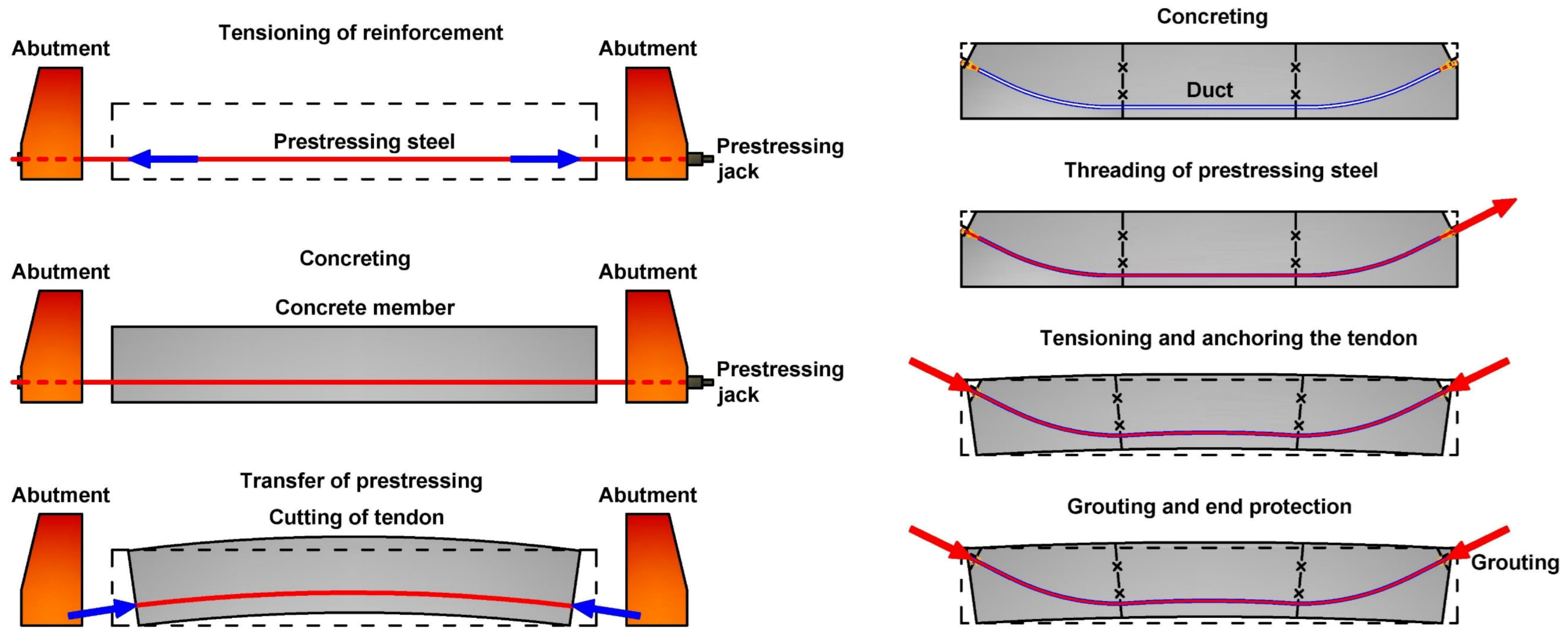


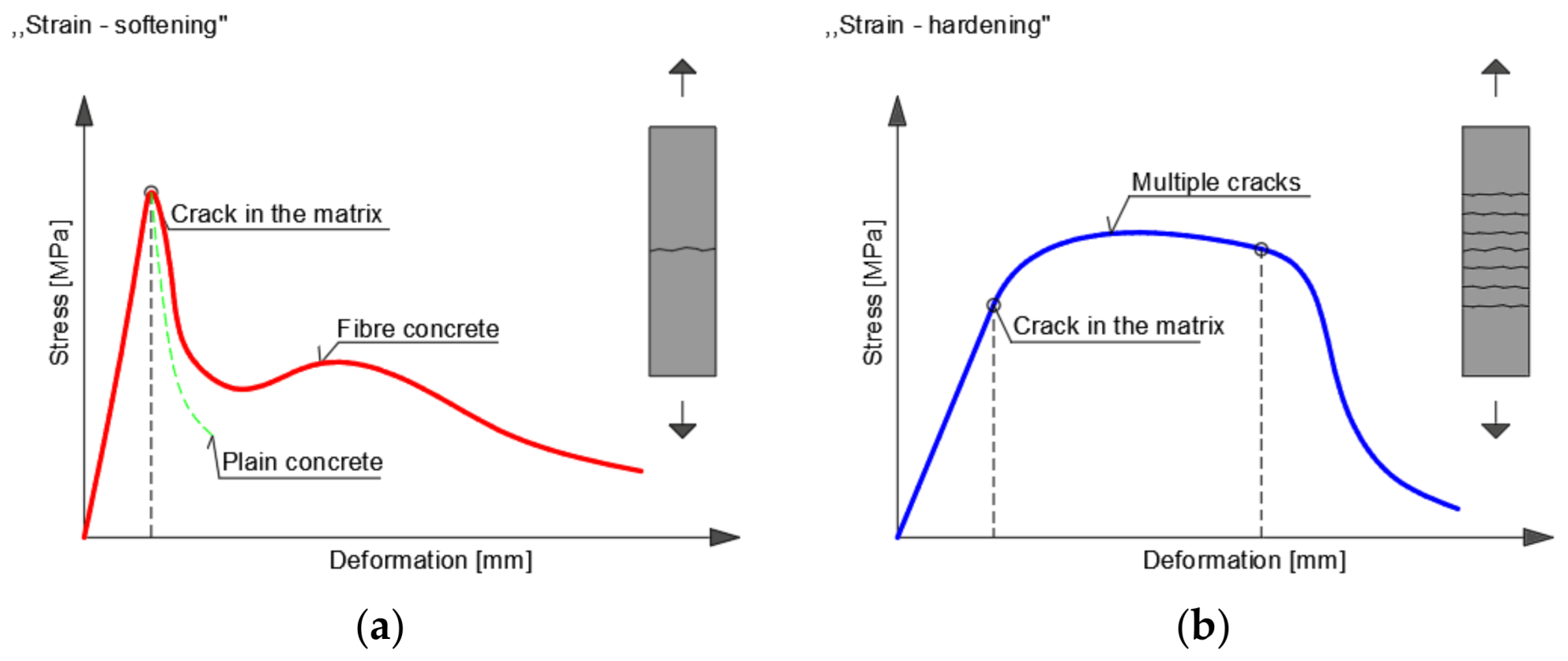

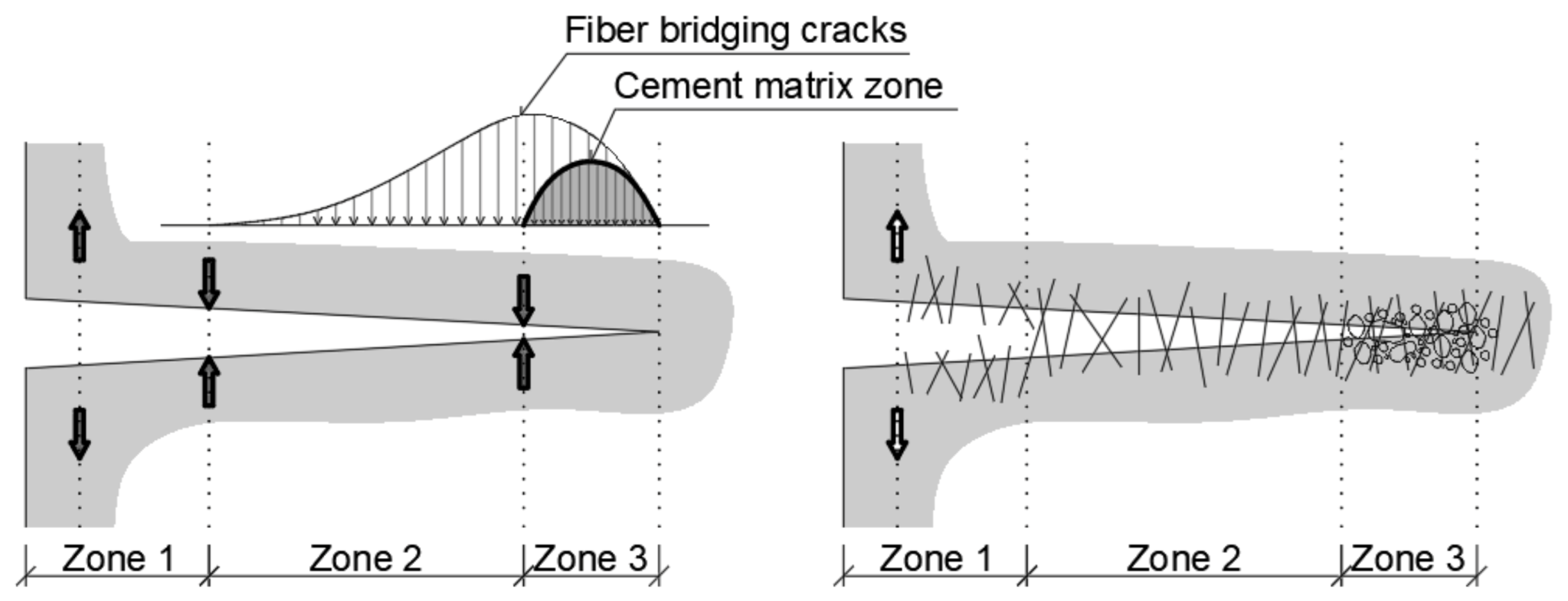
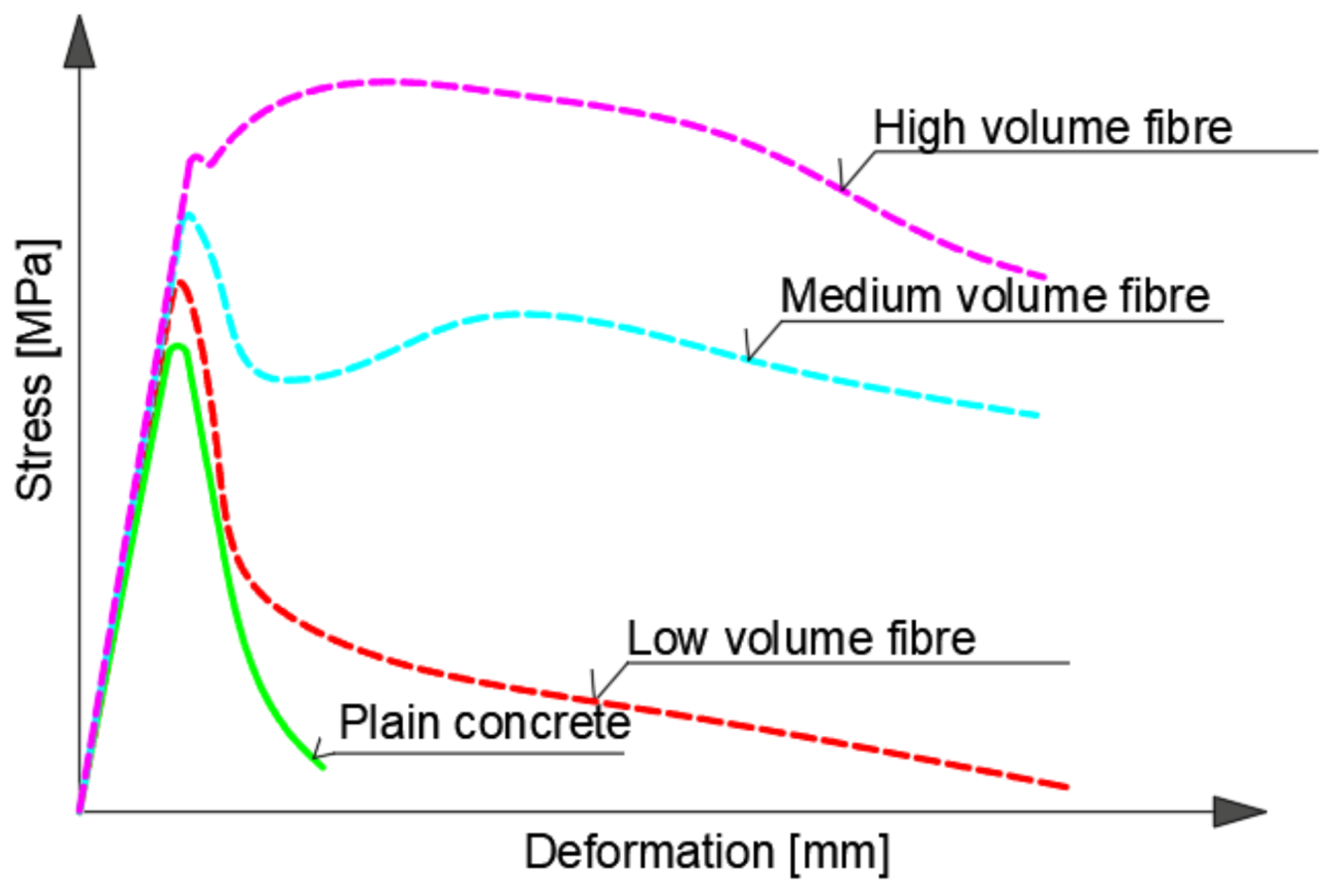


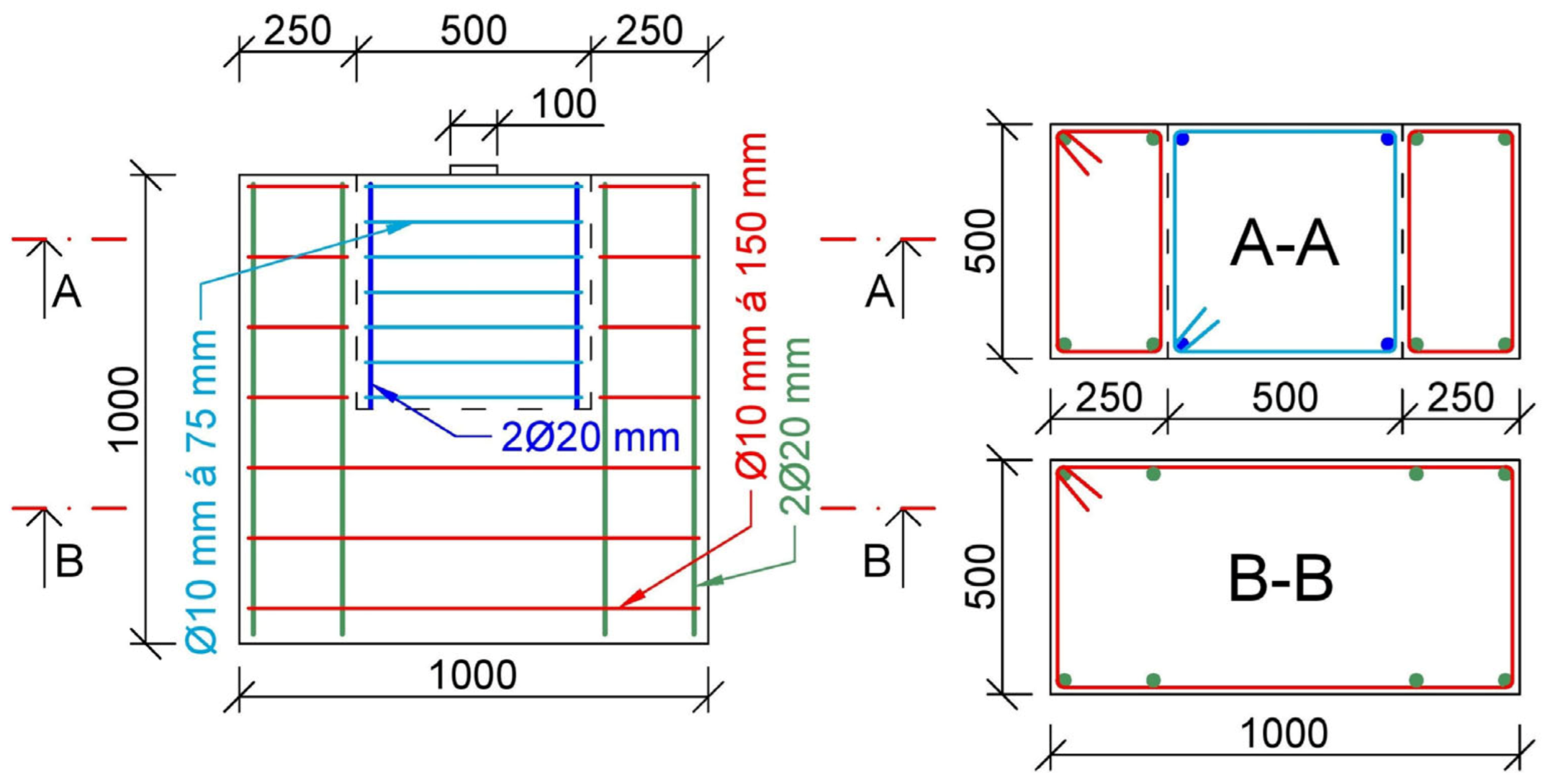
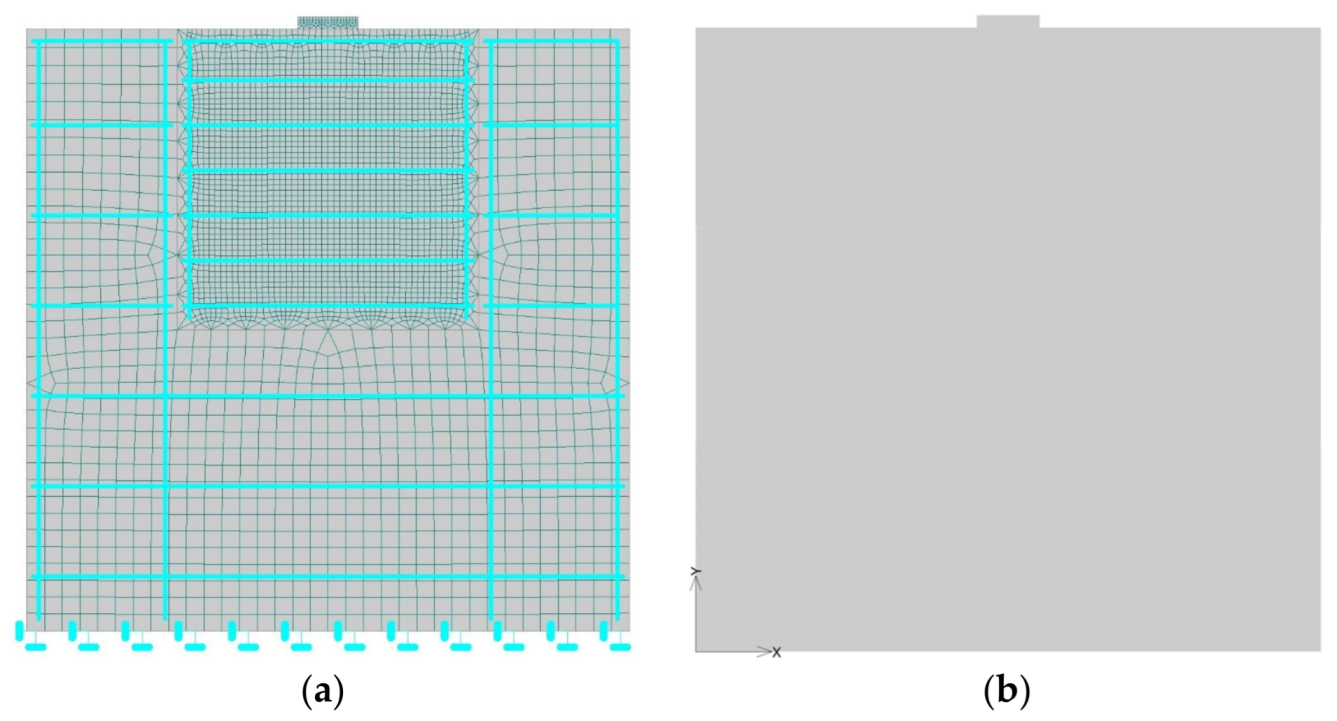

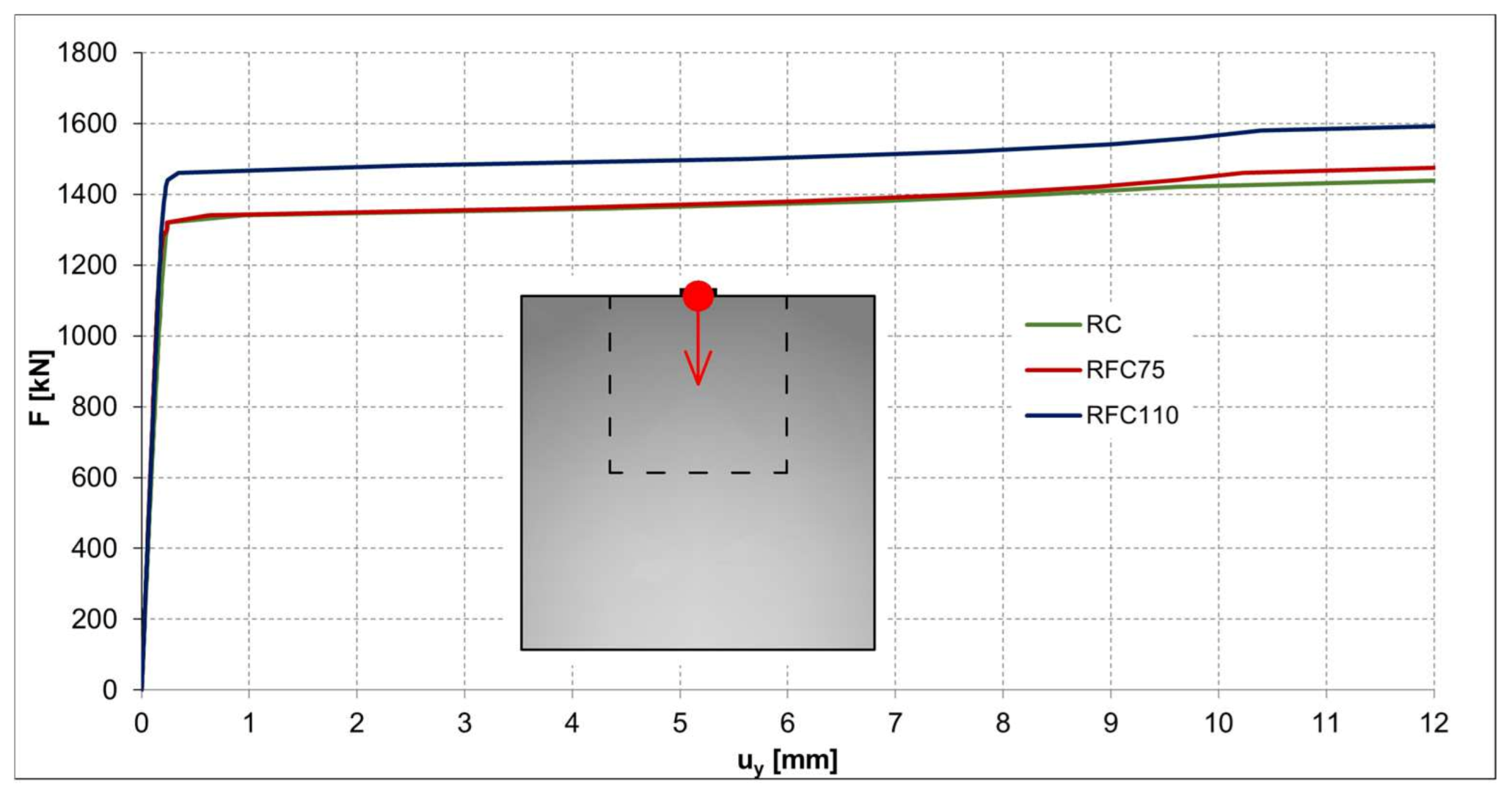
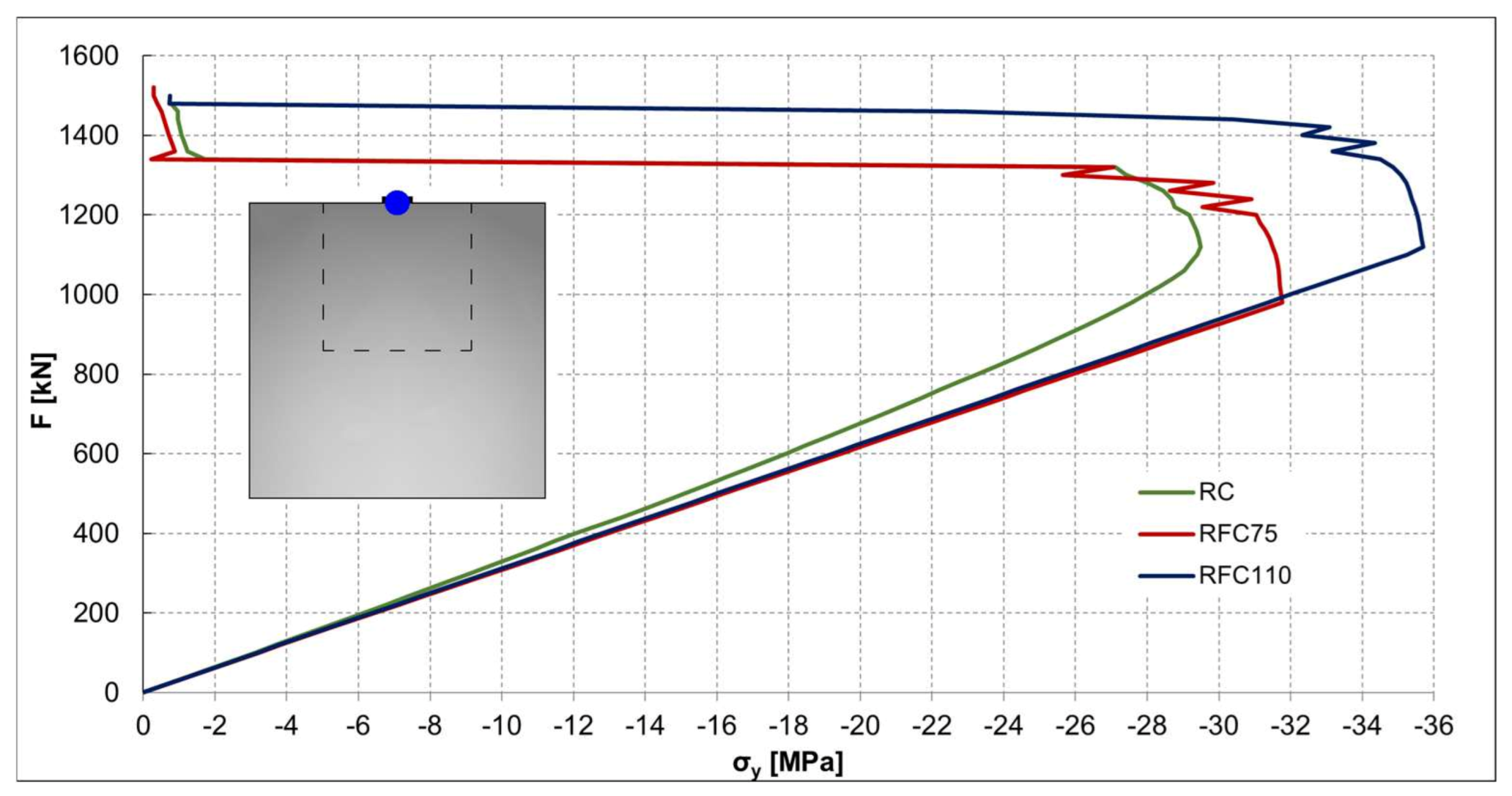
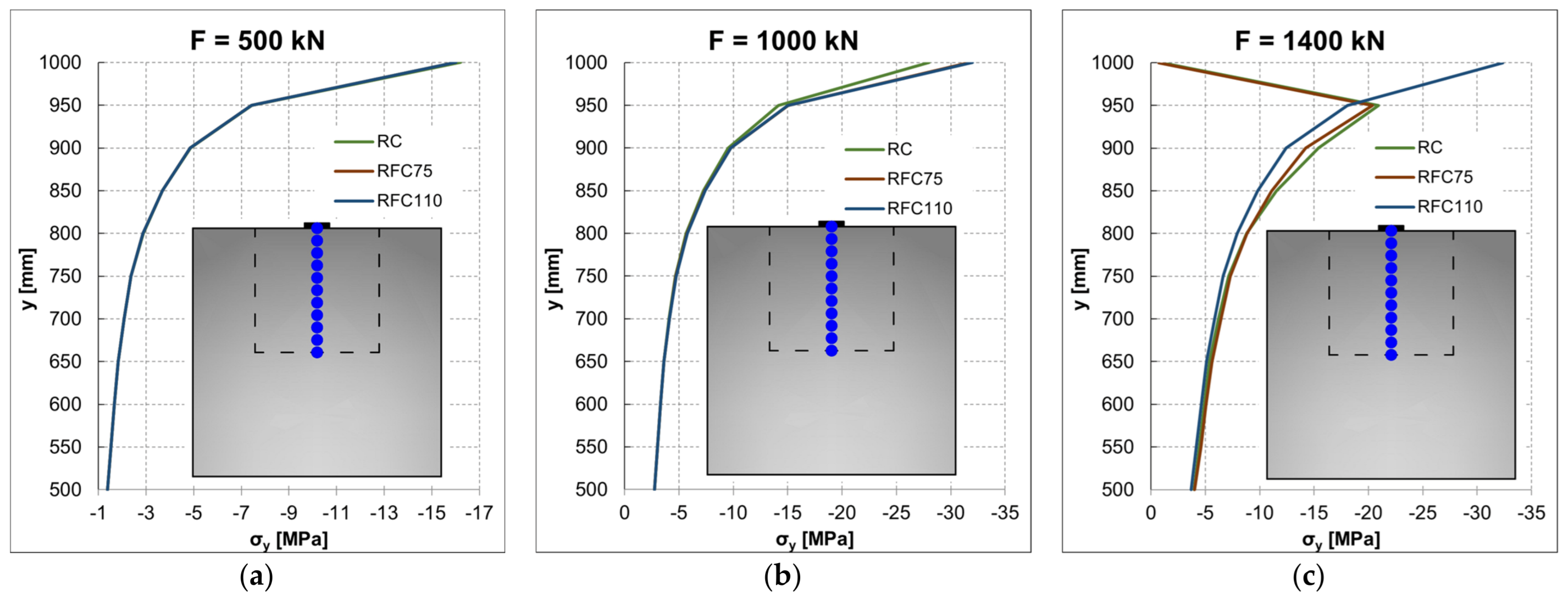



| Design of Mixtures | Recipe I | Recipe II |
|---|---|---|
| Denotation of Recipes | FRC (75 kg/m3) | FRC (110 kg/m3) |
| Aggregate 0/4 mm | 945.0 | 945.0 |
| Aggregate 4/8 mm | 145.0 | 145.0 |
| Aggregate 8/16 mm | 825.0 | 825.0 |
| Cement: CEM II/A—S 42.5 | 320 | 320 |
| Water | 200 | 200 |
| W/C | 0.5 | 0.5 |
| Fiber: Dramix 3D 55/30 | 75 | 110 |
| Material Parameter of Concrete | FRC (75 kg/m3) | FRC (110 kg/m3) | |
|---|---|---|---|
| Modulus of Elasticity | E [MPa] | 37,350 | 35,320 |
| Tensile Strength | ft [MPa] | 0.987 | 0.90 |
| Compressive Strength | fc [MPa] | −32.50 | −36.50 |
| Fracture Energy | Gf [MN/m] | 9.993 × 10−3 | 9.500 × 10−3 |
| Type of Material | Properties |
|---|---|
| Concrete—C30/37 (SBeta Material) | Ec = 33,010 MPa fc,cyl = 31.45 MPa ft = 2.665 MPa ν = 0.20 Gf = 6.662 × 10−5 MN/m ε = −1.906 × 10−3 wd = −5.0 × 10−4 m |
| Fiber-Reinforced Concrete “I”, 75 kg/m3 (SBeta Material) | Ec = 37,350 MPa fc,cyl = 32.50 MPa ft = 0.987 MPa ν = 0.20 Gf = 9.993 × 10−3 MN/m ε = −1.682 × 10−4 wd = −5.50 × 10−4 m |
| Fiber-Reinforced Concrete “B”, 110 kg/m3 (SBeta Material) | Ec = 35,320 MPa fc,cyl = 36.50 MPa ft = 0.90 MPa ν = 0.20 Gf = 9.50 × 10−3 MN/m ε = −1.682 × 10−4 wd = −5.50 × 10−4 m |
| Steel Reinforcement—B500B (Reinforcement—Bilinear) | fy = 500 MPa Es = 200,000 MPa |
| Steel Plates (Plane Stress Elastic Isotropic) | E = 210,000 MPa ν = 0.30 |
| Macroelement | Type of Element | Size of FE Mesh (mm) |
|---|---|---|
| Specimen—Concrete Block | Quadrilateral CCQ10SBeta | 30 |
| Anchorage Block | Quadrilateral CCQ10SBeta | 10 |
| Steel Plates | Quadrilateral CCQ10 | 5 |
| Type of Anchorage Block | Crack: Fcr (kN) | Failure: Fu (kN) |
|---|---|---|
| RC | 1000 | 1320 |
| FRC (75 kg/m3) | 980 | 1320 |
| FRC (110 kg/m3) | 1140 | 1440 |
Disclaimer/Publisher’s Note: The statements, opinions and data contained in all publications are solely those of the individual author(s) and contributor(s) and not of MDPI and/or the editor(s). MDPI and/or the editor(s) disclaim responsibility for any injury to people or property resulting from any ideas, methods, instructions or products referred to in the content. |
© 2023 by the authors. Licensee MDPI, Basel, Switzerland. This article is an open access article distributed under the terms and conditions of the Creative Commons Attribution (CC BY) license (https://creativecommons.org/licenses/by/4.0/).
Share and Cite
Vavrus, M.; Kralovanec, J. Study of Application of Fiber Reinforced Concrete in Anchorage Zone. Buildings 2023, 13, 524. https://doi.org/10.3390/buildings13020524
Vavrus M, Kralovanec J. Study of Application of Fiber Reinforced Concrete in Anchorage Zone. Buildings. 2023; 13(2):524. https://doi.org/10.3390/buildings13020524
Chicago/Turabian StyleVavrus, Martin, and Jakub Kralovanec. 2023. "Study of Application of Fiber Reinforced Concrete in Anchorage Zone" Buildings 13, no. 2: 524. https://doi.org/10.3390/buildings13020524
APA StyleVavrus, M., & Kralovanec, J. (2023). Study of Application of Fiber Reinforced Concrete in Anchorage Zone. Buildings, 13(2), 524. https://doi.org/10.3390/buildings13020524







